The art of ikebana: Japanese flower arrangement when heaven, Earth and human elements unify
I have practiced ikebana for eight years now. Starting at my first apartment in the Mediterranean, well before traveling to Japan, I adopted my own, personal style. As a creative person I believe in the regenerative impact of knowing while breaking the rules. At first I was seeking a mindfulness practice to ground me, to connect me with the here and now. A seated meditation was very challenging for my movement relishing self back then, so I needed a bit of action in my practice, I took on calligraphy but I needed more nature. What attracted me further to this eastern form of artistic expression is the ephemeral quality of flowers, their seasonal variety as the remainder of perpetual change in nature and the universe, and of course its aesthetic appeal to my harmony seeking eye.

Ikebana at Reikanji, Kyoto
What is distinct about ikebana versus Western flower arrangement
Ikebana is a Japanese flower arrangement traditionally conceived to unify the trio of heaven, Earth and human elements in a simple, home or temple adorning activity. The style of the craft feels very contemporary. Its simplicity, seasonal sensibility and sustainable ethos attract the millennial tastes. In a way, having just a few elements to focus on punches more impactfully in the eye and the mind than most lustrous Western flower bouquets. Sometimes it is so simple – such as that autumn branch I found on the sidewalk on my way home perfectly fitting that one vase set above my tea cabinet. This is also an artform, be it almost labor-free but engaging the mind creatively. Just finding the match of the colorful branch, vessel and place is a minimalist expression of mindfulness.
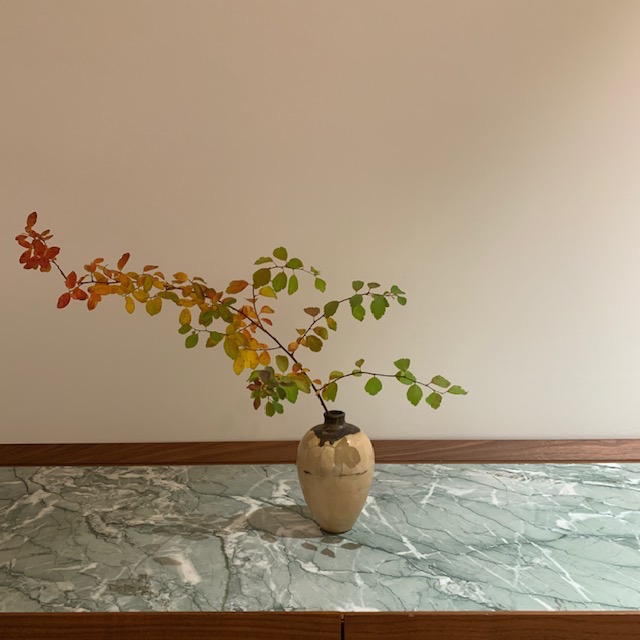
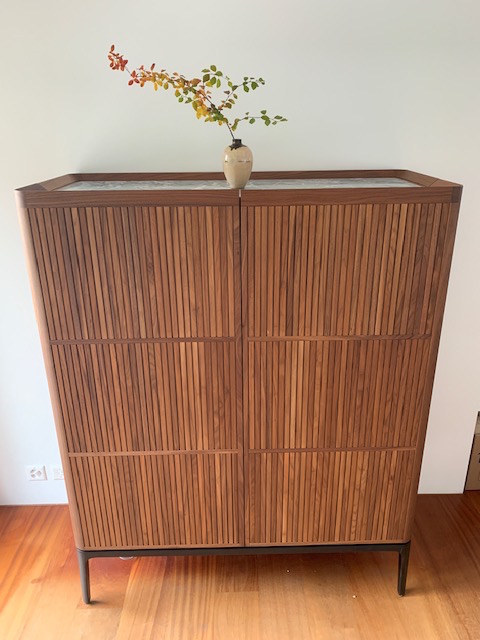
I took an ikebana flower arrangement lesson with a Japanese florist in one of my favourite tea shops in London, the city where I also learned how to professionally arrange flowers in the Western fashion at the iconic Judith Blacklock Flower School in Knightsbridge (the author and tutor also offers classes online for convenience and safety, but once you can join in person a walk through a flower market before the class additionally illuminates the day). Both of my lessons were accompanied by a friend which made for even a more meaningful experience. I highly recommend anybody taking a friend for such an aesthetically enriching ride through the plant world.

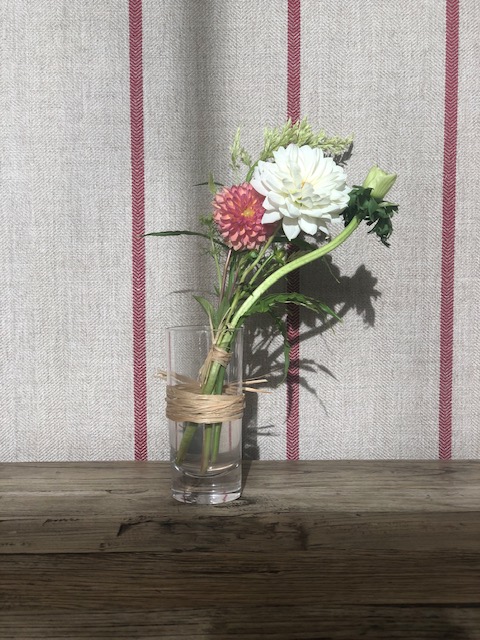
Find real connection with nature through ikebana
While today most practitioners of ikebana, particularly those based in the cities, usually purchase their flowers and branches at a florist, I encourage you to collect yours in nature. Walk in a park, pick a stem, a branch, or go to a forest for a more diverse plant discovery. Now I live next to a forest, so I take a walk with the shinrin yoku mindset collecting one, two and a maximum of three plant pieces that impressed me. Often, they already lie on the forest floor waiting for a savvy human eye to put them to use. In this way, when I am not bending the tree’s branches to crack my pretty piece, I am even closer to heaven, than anyone buying imported flowers from greenhouses in Holland and elsewhere. Lee Ufan found this magic interconnectivity transcending the self through his art. The tao dwells in ikebana, you do not have to see it as it will find you effortlessly.


Active mindfulness practice beautifying your home
The entire process — from selecting the branches, leaves, buds and flowers in season — through selecting the right vessel to nurture them indoors — to the arrangement itself, is a wonderful mindfulness practice. The meditative effect will enrich your day. Ikebana is as much about your, human relationship with space as it is about expanding your inner self through simplicity in action. My mind, body and soul are unified in this ancient Japanese floral art. Ikebana is also a perfect match for chanoyu (tea ceremony ritual). For me it is a yogic ritual involving the tools of nature in the union.
As with any practice, it evolves into craft, perhaps even mastery overtime. Yet, beware of perfectionism for it has no place in ikebana. In a true wabi-sabi philosophy, see the marvellous in the “flaws” and the impermanence. If there are any broken leaves, squashed or browning petals or asymmetry, celebrate it. Acknowledge the weakness and elevate it by finding the beauty of it. After all, human perception, and a unique taste to one’s own that changes depending on circumstances, decide whether something is beautiful or ugly, ideal versus imperfect, too young or past its prime, pleasant or repulsive, … Accept what is, shed this dualistic judgement, and you will free yourself from the burden of negativity. Ikebana is a lesson for life, not just for the act of arranging flowers.
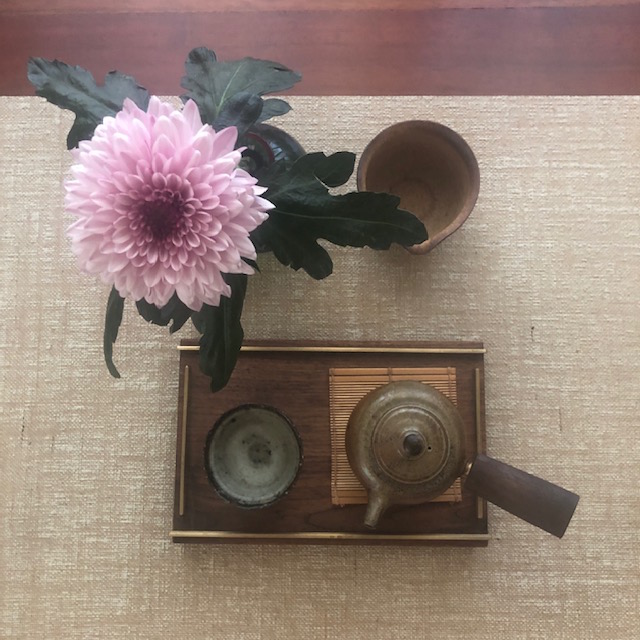
How to do ikebana at your home
Essentially do not rush. Only practice ikebana when you do not have time constraints like an appointment or work to attend to. A weekend is perfect, and if you have kids engage them too. They happily bring you the bounty of the forest or a park to your knees. To be mindful of nature, the only rule for the kids should be to be constrained to what already is on the ground. You can even each arrange your own ikebana back at home later. This practice shall transport you beyond time. As anyone who has experienced the state of flow in doing something you enjoy, being so deeply immersed in the activity, your mind dissolves and loses track of time.
Ikebana is also an incredibly geographically telling snapshot of the area where your plant material comes from. Pictured below on the left are my pickings from the hiking trails around Los Angeles, while on the right a run along the Hudson River in New York sprung these beauties into my nose.


It starts with the selection of your material, the ephemeral plants (although some like branches and dry grasses will last for months, even years which I love to reuse in other ikebana arrangements in the future when I feel like). Select only a few that attract you. As I wrote earlier, pick a maximum three and ideally of they were fallen on the ground. Whether you cut off from tree or not, you need a sharp pair of sheers. One strong enough to cut woody branches, another precise enough for delicate blossoms and leaves as you will be adjusting the height and need to cut the bottoms at an angle for the water reaching the widest possible surface increases the longevity of the cutting. I use my flower arrangement tool-set from Japan for everything – bonsais, ikebana to Western styles.


At home, find a calm, clean and warm place to do ikebana. Also seek a plain area where your creation will adorn your home best, but you can do this after the arrangement is completed. The choice of suitable vessel, a bowl or vase with natural glaze, shall ideally harmonise with the plants. Having a few makes your work more flexible. Traditionally in Japan a low container is used for ikebana. For this you need a pin frog, called kenzanin, which is a heavy metal base with sharp closely set pins that by piercing through the bottoms of the stems will hold them at a desired angle upwards. Later, this will be immersed in water for the plants to sip on. In the West, a firm foam is used to set the stems in your arrangement, but this is unsustainable as you have to throw away this usually synthetic and hard to recycle material after each use. When I travel I have no pins and find whatever vessel appeals to my eye. At a hotel in London I only had a basic water glass, so I wrapped a bunch of straws around to improvise for my own vase, while at another hotel in New York a bone white ceramic toothpaste and brush holder matched my Westside bush plucking.
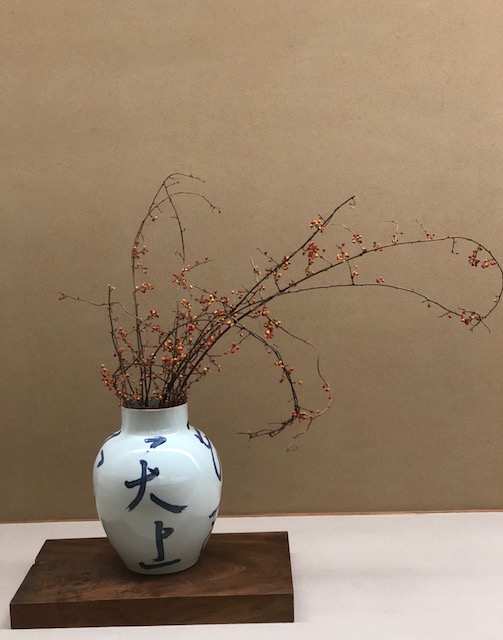

Now, work in a relaxed mindset, manipulating the plants with your human aesthetically confident eye “to form harmony in negative space”. Like in human communication, think of how each piece will interact with one another in the arrangement. This mirrors your sensibility. Ikebana is as much about your relationship with space as it is a mindfulness practice of simplicity in action.
No other activity of “improving” your home feels as satisfying, creatively spontaneous, yet entirely being in synchrony with nature as ikebana does. It is not reserved to women only, we shall fully embrace male attraction to flowers and let them bloom through the practice.


Not only indoors you can find ikebana gracing through its simplicity your heart. Often, landscape designers incorporate this concept, and villagers adorn their homes with these harmonious dialogues between the place and the plant. The above examples from France and Japan display what I mean well.

